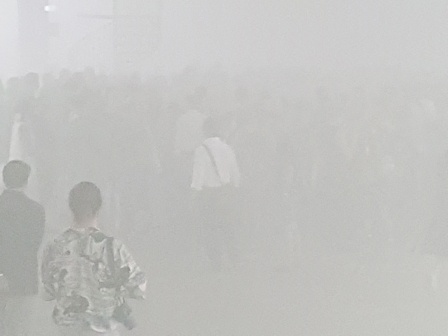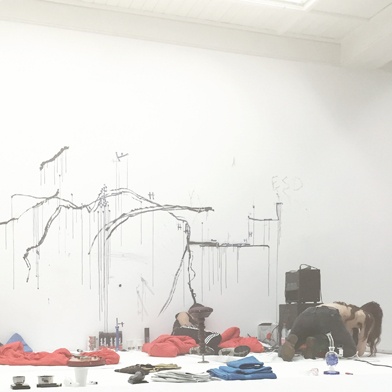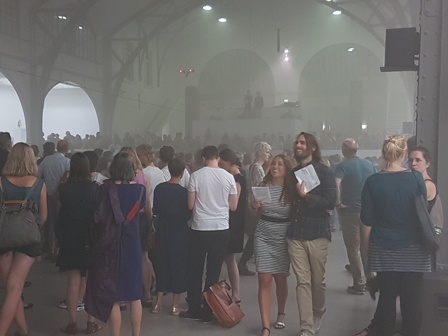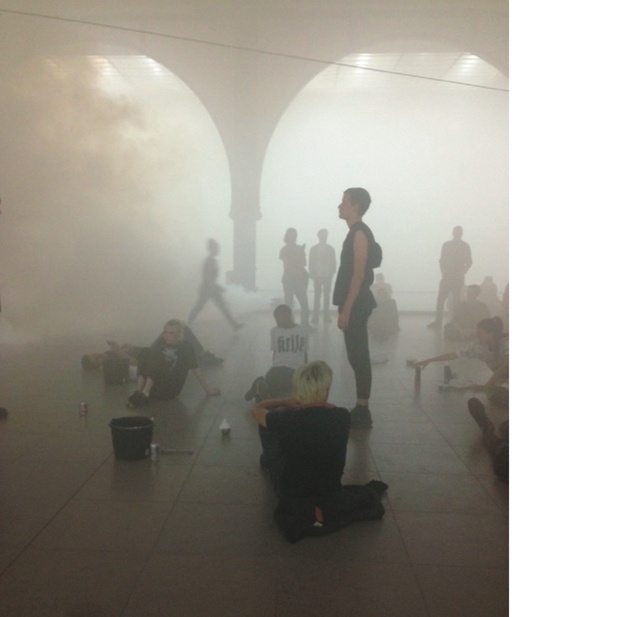Sharing Angst Gaby Tront on Anne Imhof's "Angst II" at Hamburger Bahnhof, Berlin

It is the feeling that broadly registered this June when it was announced that the British electorate had voted to leave the EU, and it is the feeling that many experienced this November, when it was clear that the American people had elected a pseudo-populist reality-TV-star billionaire as the nation’s next president. And yet this feeling, angst, is a feeling that neoliberalism – broadly understood as the catalyst for these and other recent unnerving shifts in global power – typically acts to suppress. Fear, worry, and disenfranchisement are not part of the neoliberal “brand” (unless, perhaps, one is speaking of the simulation of these negative qualities, activated for the edification and enrichment of a given individual). But of course this feeling is hardly rare. Officially outside of the program of cruel optimism, it is nevertheless a by-factor of its conditions, as well as a kind of dark opposite to which neoliberalism is perpetually promising an easy solution.
Anne Imhof’s broadly embraced durational performance “Angst II” (presented several times over the course of multiple days at Berlin’s Hamburger Bahnhof this fall, following another iteration of the work at the Kunsthalle Basel this summer) could be read through such a framing of the term. Particularly the last notion: angst as a tool for the capitalism that describes our present, which is to say one that targets our affective register. As an affect, angst is arguably the emotion most capable of transgressing individual boundaries, of inciting a state of exception. Think of the horror-flick audience, regardless of gender, fearing for the “final girl”; or of the electorate, disillusioned by our “like”-only variety of neoliberal governance, being corralled by obscure outside threats into the hands of polemical demagogues.
Teenagers seem to intuitively understand that angst, more than, say, humor or grief, is a powerful force for holding attention; that angst is viral in itself. Imhof’s “Angst” understood this too, comprised of so many possibly angst-inducing actions: a tightrope walker, a fleet of drones, young performers languidly shaving each other with razors, an immense yet enclosed public space filled to capacity; and then there are the allusions to drugged bodies, bodies not just resting, but out of commission together. Incapable (together) of neoliberal participation. In the world Imhof stages, bodies switch on and off – often in the middle of an action. These aborted gestures and objects seem to take on shamanistic significance. Shades of Beuys minus overtly kitsch politics. Rather, small but persistent indications of things getting ever-worse characterize Imhof’s “Angst,” the kind of click-baity vignettes that drive social networking feeds, that form community through a shared feeling of precarity and the threat of collapse.
 Anne Imhof, "Angst II," Hamburger Bahnhof, 2016
Anne Imhof, "Angst II," Hamburger Bahnhof, 2016
The mythological and the Internet share the abyss. For both, the origin of a narrative is unclear or necessarily empty or blocked, an omega-point for the individual’s perception of the world (which is overwhelming). There is likewise a sense in Imhof’s work that her scores are not unilinearly pre-scripted but algorithmic, the choreography dictated by a draw distance calibrated to the attention span or physical proximity of the average viewer; that by merely crossing a certain threshold (of space, of duration), a viewer can catalyze a new sequence: a young woman attempts the tight rope, a drone takes off, another woman ascends a freestanding staircase (leading nowhere). As with a good video game – always promising another development, another part of the digital space activated – it is very hard to pull oneself away, even if, post-facto, one can see how Imhof’s work is fractal, that experiencing any one part unlocks the code to the larger experience. But while in the work’s trance, the experience is neurologically arresting, like a Shepard tone beat programmed to perpetually ascend but never drop. One could, here, connect Imhof’s “Angst” series to Matthew Barney’s “Cremaster” cycle; both hinging on highly mediagenic motifs, seemingly loaded with deep narrative significance, but which play out more like a roto-relief of the tension between so many tropes strung together. But is that it? Is that the key to “Angst”? Just the nihilism of playing non-stop video games (so to speak) despite neoliberalism’s productivity-oriented mandate, that expenditure of energy but refusal to work, refusal to build one’s network, to seek edification and/or validation beyond the screen?
Another way to read Imhof: via the 1970s contact improvisation her performers reference – which is to say a kind of rhizomatic or cybernetic choreography, with connected but decentered movement transpiring extemporaneously according to the dancers collective intelligence, sensitivity, and care of the group. In this light, “Angst” is not meaningful because it is big, void, and beautiful, but because it is collectively constituted – a form that reflects the proto-neoliberal ideal of interaction determined by flat hierarchies and self-empowerment (i.e., prior to the self-instrumentalization version-update). Indeed, non-activity, angsty non-participation figures as a key aspect of Imhof’s work, and this is true both of her performers and her viewers. In the work, her dancers languish on raised platforms, on each other, on the bare floor interspersed with viewers, who are also, given the long duration of the piece, variously resting on the ground in proximity to whatever given action has their attention. Viewers and performers stand by, present in the way that one is present while scrolling social media but not reacting. As such, and sharing a general dress code and age, bodies in “Angst” blend within a shared cool-kid millennial aesthetic scape: glass bongs and cartons of Marlboros, metal-show T-shirts, DIY tattoos, white to-go coffee cups, multipacks of Gillette shaving cream, metal vessels and black cords, and other signifiers that, amid the masses that fill the space and against the blank institutional walls, take on a kind of semiotic value; One is compelled, for instance, to project probably undue significance into cans of Diet Pepsi being opened, then poured out zombie-like against the wall, the cola pooling at the baseboard of the concrete floor. The room could be mistaken for early morning at Berghain or a presentation by HBA (performers intermittently crossing the space with the conviction of walking a runway), haze machines clouding visibility, making the large venue feel private; turning objective institutional space into intimate club space; faces blur, bodies become distant and approximate or immediate and private.
But unlike Berghain, everyone gets in: 10,000 square meters of Gallery Weekend art-event consumers (myself included) and their tote bags; this isn’t a club, this is club coding for a mainstream public art work. Considering her title, and the (re)production of a diffuse scenario of threat, one could call it populist. Regardless, Imhof is perhaps the first Großkünstlerin to come out of Germany in a decade; the recent reception of her work (further underwritten by Imhof’s representating Germany at the upcoming Venice Biennale) suggesting her practice has the iconic potential of Eliasson, Tillmans, and Genzken. This achievement of holding viewers’ attention (albeit by employing the common tricks of celebrity and beautiful youth, even if via her own circle of friends and their non-gender conformity) for a sustained period is not nothing. And if such a feat was notable at the time of Barney’s “Cremaster,” it is all the more compelling now, given the incredible competition one must fight to even be seen, let alone sought out in today’s attention economy.
 Anne Imhof, "Angst II," Hamburger Bahnhof, 2016
Anne Imhof, "Angst II," Hamburger Bahnhof, 2016
As such, Imhof’s work is capable of reflecting broader contemporary patterns of social interaction and circulation; the particular proximities of intimacy and distancing that play out on social networks, the crowds of viewers aggregating around this or that action, as if “liking” it with their presence, and the peripheral activity (including the remediation of the performance) going on beyond these clusters; there is also the sense of surveillance by other viewers, by the hosting venue (which, like a social media platform, is duly benefitting, on a meta-level, from the increased traffic, the public-attendance numbers no doubt to offer some degree of leverage for funding in the institution’s annual report), and by the actors scanning the viewers, reacting to the crowd. And not unlike the seeming generosity of social media channels, wherein users can freely see, like, follow, and share but not access the algorithms of what they can view or of who sees what they say, the realization comes about that the viewers of “Angst,” in their flows of attention, have been choreographed into the piece.
One might be tempted to read this as a relational (or anti-relational) art strategy – as the viewer, in the accumulation of fog and slight terror that comes with being one among such a mass of bodies, is certainly conscious of their presence. But unlike the common goal in relational art, “Angst” neither problematizes the viewer’s position as part of the masses nor aims to mobilize this group at large; As aforementioned, the piece is fully tolerant of passivity; there is no ’dead weight.’
In canonical accounts of performance art, a central medium for feminist discourse, the potential for interactivity was highly valued. The possibility of empowering both the performers (who might just act ’off-script’ or at least in an anti-representational way) and the audience members (who, at any moment, could directly interfere with what was going on) promised disruption of social norms and presented a two-channel narrative rather than a unidirectional stream. But such a vocabulary of empowerment is no longer trusted, thanks, for one, to its overuse in commercial language (not least, the ad copy of zombie-consumer feminism). Moreover, and as has been broadly expressed in theory of the past decade, interactivity has come to stand in as a medium of unremunerated labor, so that it no longer holds the political promise the Judson Church sphere took it to possess. But here, that’s of little matter as Imhof did not ask for it anyway. Rather, she created a scenario wherein a common public was cohered through the incredibly simple – and in Imhof’s case incredibly beautifully executed – reflex of sharing an emotional state.
“Anne Imhof: Angst II,” Hamburger Bahnhof, Berlin, September 14–25, 2016.
 Anne Imhof, "Angst II," Hamburger Bahnhof, 2016. Foto: Calla Henkel
Anne Imhof, "Angst II," Hamburger Bahnhof, 2016. Foto: Calla Henkel
